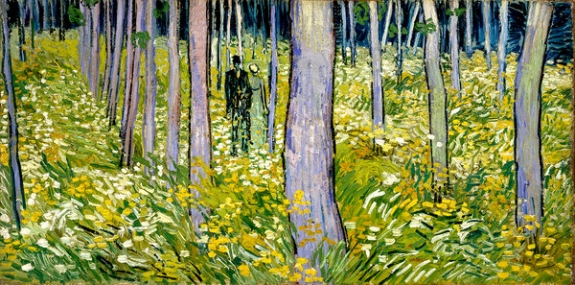Vincent van Gogh was shaken but also calmed by nature. The natural landscape inspired some of his most implacably innovative paintings, roiled of surface, ablaze with color and steeped in feeling. They are blunt, irresistible instruments for seeing. Yet nature — and its tiniest details in particular — also sharpened his visual acuity and soothed and comforted his often unstable personality.
In the catalog to “Van Gogh Up Close,” a succinct, revelatory exhibition at the Philadelphia Museum of Art, the art historian Anabelle Kienle notes van Gogh’s repeated references in his letters to “a blade of grass,” “a single blade of grass,” “a dusty blade of grass.” He not only thought that something this small and modest was a worthy subject for art — as demonstrated by the spare works of the Japanese artists he so admired — he also invoked it as a kind of centering technique for regaining concentration. Writing to his sister-in-law, he recommended focusing on a blade of grass as a way to calm down after the tumult of reading Shakespeare.
“Van Gogh Up Close” has been organized by Joseph J. Rishel and Jennifer A. Thompson, curators in Philadelphia, working with Ms. Kienle, a curator at the National Gallery of Canada in Ottawa, and Cornelia Homburg, an independent scholar. It examines van Gogh’s relationship to nature at its most intimate, cutting a narrow path through his achievement, with 45 often small, sometimes seemingly tossed-off paintings. In doing so it manages to lead us to the fullness of his achievement along a fresh and eye-opening route.
The show focuses on van Gogh’s tendency to depict nature in close-up, either in teeming detail or with a highly compressed sense of space, sometimes achieved by high horizon lines and thick brushwork that flatten the image and appear to push the surface of the picture close to the viewer. It includes a cache of unfamiliar works from abroad, some of which are being exhibited in this country for the first time anyone can remember. Stellar among these is a strange wonder titled “Garden in Auvers,” with its patchwork of dotted walkway and heaving, dappled lawn erupting with tangled oval flowerbeds that seem about to toboggan out of the painting and land in our laps.
As might be expected, the show centers almost exclusively on landscapes, aided and abetted by a few still lifes of flowers and fruits. It is devoid of portraits, self-portraits and interiors. There is little indication in the art, the wall texts or the excellent, extravagantly illustrated catalog of van Gogh’s fraught relationship with Paul Gauguin, his bouts of mental illness or the partly sliced-off ear.
Devotees of van Gogh as crazed visionary may be disappointed by this low-key approach, but they may also appreciate having his visionary genius grounded so specifically in tangible experiences of the real world.
The works here span his intensely productive last four years, from his arrival in Paris from Antwerp in early March 1886 to his death in Auvers in July 1890. In three still lifes of flowers painted early in his stay in Paris, he begins to grapple with the heightened colors, brighter light and greater tactility of the Impressionists, which he was seeing for the first time. He remained in Paris almost two years, living with and supported by his devoted art dealer brother, Theo, drinking in art, meeting artists and collecting Japanese prints, with which he decorated his room.
But Paris left van Gogh frazzled and on edge. In February 1888 he headed south to Arles, dreaming of establishing an artists’ colony, but mainly in search of the respite of nature, along with light and color that would enable him to surpass the Impressionists. That he did so is evidenced by the “Sheaves of Wheat,” which reads as a hallucinatory, muscle-bound version of something by Monet, whom van Gogh greatly admired.



